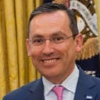Officials
Offical

Marlon Tábora Muñoz, who has spent much of his career working on his nation’s finances, presented his credentials as Honduras’ ambassador to the United States to President Donald Trump on April 24, 2017. It’s his first such post.
Tábora was born April 3, 1969, to José Ernesto and Hilda Muñoz Tábora in Santa Rosa de Copan, in Honduras’ western region. He went to José María Medina school there until moving to Tegucigalpa, Honduras’ capital, in the fourth grade. Tábora then began at Instituto Salesiano San Miguel, where he completed secondary school.
Despite spending much of his career working on financial issues, Tábora started on a path to be an engineer. He earned a B.Eng. mechanic industrial engineering in 1990 from Universidad Nacional Autónoma de Honduras, and then a master’s in technical marketing and international business in 1994 from Universidad Tecnológica Centroamerica (Unitec). Tábora later continued his education with a doctorate in science administration in 2001 from Universidad Católica de Honduras and finally a master’s in public policy from George Washington University in 2013.
Tábora began his work career at the Honduran Telecommunications Company (HONDUTEL), serving as a project engineer and an infrastructure project manager. In 1993, he left to manage construction of the headquarters for the Banco Central de Honduras Central (Honduras’ Central Bank). In 1995, he joined the Grupo Inversiones La Paz, also known as Groupo Maduro, which was led by Ricardo Maduro, who was elected president of Honduras in January 2002.
In March 2002, Tábora was named president of Comision Nacional de Telecomunicaciones (CONATEL), Honduras’ national commission on telecommunications. He resigned in June 2004 and worked for a couple years as a consultant for the Economic Commission for Latin America and the Caribbean.
Tábora moved to Grupo Terra, a Honduran company involved in infrastructure construction, real estate development and power generation, as new business development manager in 2006. The following year, he was made vice president of infrastructure.
In November 2009, Tábora was elected as the first deputy of the National Party in the department of Francisco Morazán.
In January 2010, he took over as vice minister of the presidency and chief of staff to Honduran President Porfirio Lobo, after serving as an advisor to his presidential campaign. Five months later, Tábora moved to Washington to serve as senior counselor at the Inter-American Development Bank (IDB), which finances development in Latin America. In 2013 he was made IDB’s alternate executive director for Central America and Belize and was named coordinator of the government’s economic cabinet.
Tábora returned to Tegucigalpa in January 2014 to take over as president of Honduras’ Central Bank—just ten years after, as an engineer, he had overseen construction of its headquarters. However, his tenure there lasted only until August 2015. He then was back at IDB, this time as executive director for Central America and Belize, a post he held until taking over the embassy.
Tábora and his wife, Saira Esmeralda Ponce, have two children, Marlon and Isabela. Ponce has served most recently as Honduras’ alternate representative of Honduras to the Organization of American States.
-Steve Straehley, David Wallechinsky
To Learn More:
Marlon Tábora Muñoz (Wikipedia)
El BCH No Está Diseñado Para Financiar Déficit Público (El Heraldo)
Honduran President Lobo’s Cabinet Takes Shape (U.S. State Department/Wikileaks)
- Latest News
- D.C. Public Schools will Teach all Second-Graders to Ride a Bike
- New Rule in Germany Limits Sales of Sex-Themed E-Books to 10pm to 6am
- What Happened to the 6-Year-Old Tibetan Boy the Chinese Government Kidnapped 20 Years Ago?
- U.S. Ambassador to Turkey Photoshops his Hair Color to Mock Turkish Mayor
- Mystery Artist Calls Attention to Unfixed Potholes by Drawing Penises around Them





